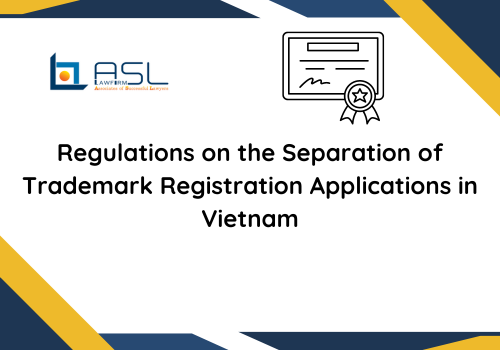During the process of trademark registration in Vietnam, applicants may request to separate their trademark registration applications for various reasons. This article will outline the regulations of Vietnamese law regarding the separation of trademark registration applications.
According to Article 115, Clause 1 of the Unified Document No. 11/VBHN-VPQH 2022 of the Law on Intellectual Property, before the state management agency issues a decision to grant a protection certificate or notifies the refusal to grant a protection certificate, the applicant has the right to separate the trademark registration application.
The modification or supplementation of the industrial property registration application should not expand the scope of the subject matter already disclosed or specified in the application. The essential nature of the subject matter requested for registration in the application should not be changed, and the unity of the application must be ensured.
If a request for separation is made, the requesting party must pay additional fees and charges. In the case of separation, the date of submission of the original application is considered the date of submission of the separated application.
Why Separate Trademark Registration Applications?
Separating trademark registration applications involves dividing one or several parts of the trademark from the original application into one or more new trademark applications. For example, an applicant can separate different components or split a portion of the goods or services category that was originally registered into corresponding new trademark applications.
Separated applications are assigned new trademark registration numbers and retain the filing date of the original application, or (if applicable) the priority date of the original application.
After the separated applications are confirmed as valid by the Intellectual Property Office, they will be publicly announced as regular trademark applications. During this period, the original application continues through the regular processing procedure.
In many cases, for optimizing the scope of trademark protection, applicants may need to separate trademark applications into two or more applications. Separating trademark registration applications provides flexibility compared to sticking to a single trademark registration. In the future, trademark owners might transfer ownership rights of a certified trademark while still retaining ownership of the separately separated trademarks.
Procedures for Separating Trademark Registration Applications
To separate trademark registration applications, the applicant needs to complete two steps: submitting a request for separation and submitting a request for modification of the original trademark registration application.
The application for separating trademark registration includes:
- Trademark registration form specifying the number and date of the original application.
- Trademark samples.
- Request letter for separating the trademark registration application.
- Power of attorney.
- Receipt for the separation fee and charges.
After preparing the application for separating the trademark and the application for modifying the original trademark registration, the applicant submits both sets of documents to the National Office of Intellectual Property of Vietnam.
Similar to a regular trademark application, the separated applications undergo formal and substantive examinations. However, the process is expedited as the assessing office continues the initial assessment from the original application.
Importantly, to ensure consistency, the same examiner in the Trademark Division conducts both the initial and separated application assessments in the same office.
The process only changes if the original application is refused a protection certificate. In such cases, the assessment may be transferred to a different specialist. However, even at the protection certificate issuance stage, the Trademark Division still consults the specialist who assessed the original application due to the prior refusal.


Leave a Reply